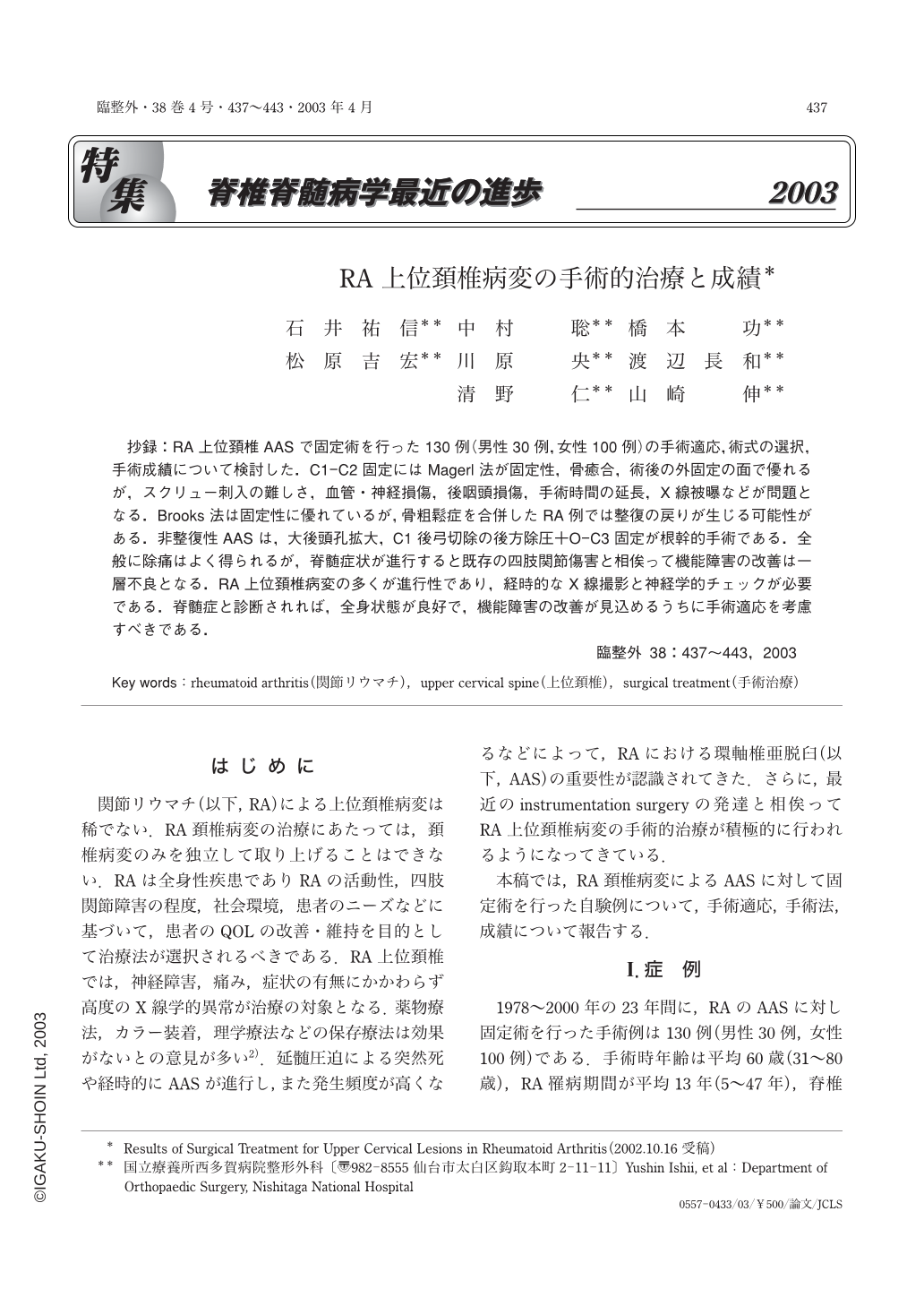Japanese
English
- 有料閲覧
- Abstract 文献概要
- 1ページ目 Look Inside
抄録:RA上位頚椎AASで固定術を行った130例(男性30例,女性100例)の手術適応,術式の選択,手術成績について検討した.C1-C2固定にはMagerl法が固定性,骨癒合,術後の外固定の面で優れるが,スクリュー刺入の難しさ,血管・神経損傷,後咽頭損傷,手術時間の延長,X線被曝などが問題となる.Brooks法は固定性に優れているが,骨粗鬆症を合併したRA例では整復の戻りが生じる可能性がある.非整復性AASは,大後頭孔拡大,C1後弓切除の後方除圧+O-C3固定が根幹的手術である.全般に除痛はよく得られるが,脊髄症状が進行すると既存の四肢関節傷害と相俟って機能障害の改善は一層不良となる.RA上位頚椎病変の多くが進行性であり,経時的なX線撮影と神経学的チェックが必要である.脊髄症と診断されれば,全身状態が良好で,機能障害の改善が見込めるうちに手術適応を考慮すべきである.
The instability of atlanto-axial subluxation remains a challenging problem in patients with rheumatoid arthritis. We reviewed 130 cases of rheumatoid arthritis complicated by atlanto-axial subluxation that was treated surgically. Fifty-four patients had presented with both a neurological deficit and neck pain, 52 with neck pain, 23 with a neurological deficit, and only one with severe atlanto-axial instability without any clinical symptoms. Posterior atlanto-axial fusion was carried out in 78 patients. The Brooks and Jenkins method was used in 45 patients, Magerl's screwing combined with posterior fusion by the Brooks and Jenkins method in 30 patients, and McGraw's methods in 3 patients. Posterior occipito-cervical fusion was carried out in 52 patients, SSI in 37 patients, the Newman and Sweetnam method in 9 patients, and Cotrel DTT supplemented with bone cement in 6 patients. A postoperative hematoma was diagnosed in one patient, instrument dislodging of Cotrel DTT in two patients, and transient postoperative cerebral thrombosis in one patient. The osseous union and stability rate was 100%after Magerl's method, 89% after Brooks and Jenkins method, 87% after SSI, and 78% after the Newman and Sweetnam method. Postoperatively the pain resolved in 92 patients (87%). Neurologically, there was improvement in 44 (57%) of 77 patients, and there was no change in the other 33 (43%);none of them was worse. Of the 20 patients who could not walk before surgery, 12 (60%) improved postoperatively and became able to walk. Pain and radiological instability without neurological deficit rarely require surgery, but it may be the only means of preventing severe functional disability when there is progressive neurological impairment. Pain was relieved by surgical treatment, but myelopathy did not improve much. Early diagnosis and early surgical intervention is the key to improving the results in patients with a neuroligical deficit.

Copyright © 2003, Igaku-Shoin Ltd. All rights reserved.


